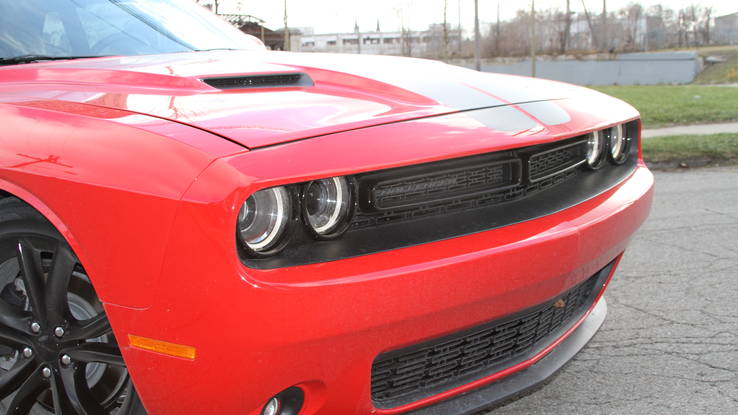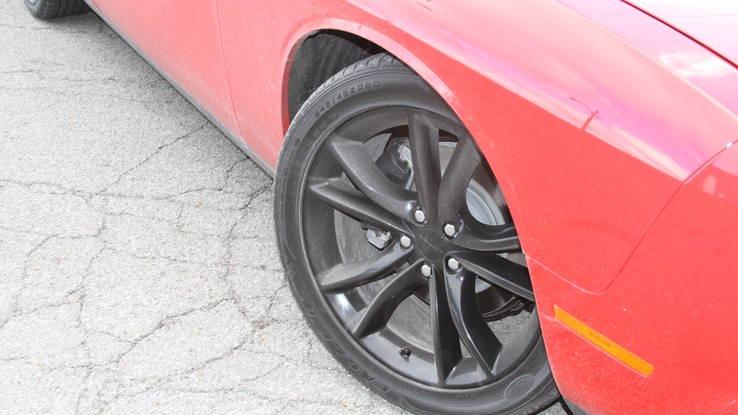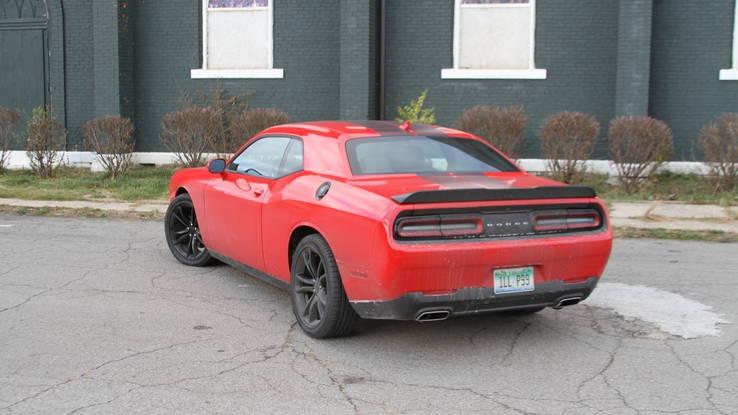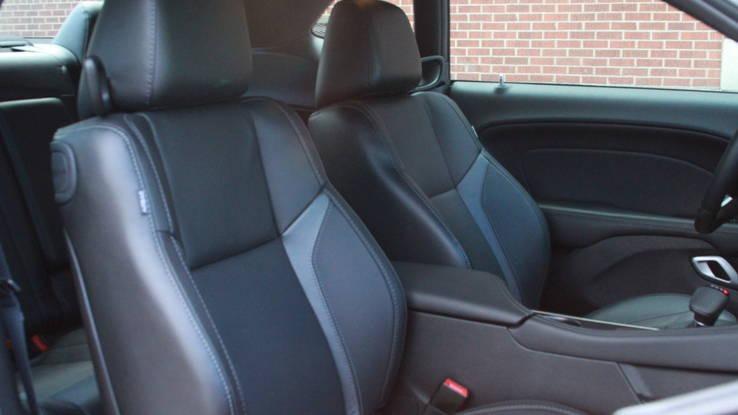Can a true muscle car have a V6?
It’s not fair to let the motor dominate the conversation about this 2016 Dodge Challenger. It’s a fine car without the Hemi, carrying its retro lines with enough confidence to offset its substantial visual bulk, and the new running lights/front fascia design and wide range of color/decal packages don’t hurt, either. FCA’s new interior refinements have, by this point, replaced nearly all of the unpleasant, crappy old plastics with better materials. The big-screened Uconnect entertainment system remains fast, functional and fairly intuitive (even if it would be nice to have a few buttons for features like seat warmers).
Even the LX platform, which is probably getting high enough up there in its years to be referred to as venerable, is as predictable and as fun as ever. Once you find a corner, it’s like swinging a sledge hammer: let the tool do the work. At its best, this a muscle machine that, unlike the newest pony cars from Ford and Chevrolet, doesn’t even pretend to look too far forward. I’m okay with that.
And don’t get me wrong: The 3.6-liter V6 is adequate — more than adequate. Not much to listen to, maybe, especially when you first hit the ignition button, but plenty fast if you’re doing the sort of soul-crushing commuting which muscle cars are meant to help us escape from.
When you do find a stretch of open road, the car will sit happily at a cruise-controlled 85-90 mph for hours without complaint. It’s rated 305 hp isn’t anything to sneeze at, especially out of a base motor. For some perspective of how far we’ve come as a species, the slant-six in the base ‘70 Challenger managed 145 gross hp and things only got worse when emissions controls were added.
So today’s Challenger SXT isn’t a bad car by any past or present standard. It’s just not as good as any of the other Challengers, and the motor is only one part of it.

2016 Challenger SXT
OTHER VOICES:
The Challenger is an excellent example of how seemingly minor styling alterations can have a huge impact on the finished car’s attitude. Glance at the Challenger Hellcat or the 392 — they look meaner, leaner. They look right. They don’t sit much lower than the SXT; the Hellcat’s only 0.7 inches closer to the ground. But that 0.7-inch difference totally changes the car’s stance, and the extra height doesn’t compliment the SXT’s slabbiness — it makes it look even bigger and tubbier than it already does.
But yeah, there’s the matter of the motor, too. Whether or not you’re in the market for it, the very fact that the Challenger Hellcat exists means that every other Challenger is going to play second fiddle. Or third or fourth fiddle — there’s quite a range of Challengers to choose from: The mighty supercharged 6.2-liter, the 392, the 5.7-liter.
This, like it or not, is last chair, the one you wind up with because you only really care about how the Challenger looks (although I’ve argued that other Challengers look better) or because you absolutely need to buy one right now. But for this price, you could get an R/T with the 5.7-liter. Who knows how much longer we’ll be able to enjoy cheap V8 power?
If you do end up with an SXT, you’re not condemning yourself to automotive hell; I think we’re all surprised to find that it’s actually quite decent with the V6. But if you’re going to buy a honking boat of a muscle car, one already burdened with its share of shortcomings (size, weight, poor visibility, so-so fuel economy), and you’re going to spend well over $ 30,000 on it, do yourself a favor and get the one you really want.
Is this the one you really want?
— Graham Kozak, associate editor

2016 Challenger SXT
“The Hellcat represents all that is right with the world. As the rest of the car world continuous to crank out ambiguous machines that have all the excitement of a bowl of oatmeal, SRT builds a car that reminds us why we wanted to get our driver’s licenses as soon as we possibly could. This car is all about excess: 707 hp, 0-60 mph in around 3 seconds and a top speed of 199 mph.”
The above quotes are from autoweek.com. I copy them here because if anything could potentially be described as a “bowl of oatmeal” it’s a Challenger with a V6 engine…
…and that description is wrong: Gotta say I like the Challenger equipped this way. In fact I surprised myself by how much. No, it doesn’t “got a Hemi” but for everyday cruising – not bad.
For starters I like the exterior and interior updates, both look appropriately retro. Inside especially, where there are cool ‘70s-looking instruments and such. Build quality looks improved from what I remember and though it looks throwback all the new stuff is there – satellite radio, ginormous touch screen, power everything…
Those decrying a Challenger with a six ignore or choose to forget a couple things. One, Dodge had six-cylinders in Challengers from day one and two, this engine cranks out more hp than a couple Dodge V8s did back in the day. This six feels to me perfectly matched to the newish ZF eight-speed automatic. Step on the gas and power and torque are on tap seemingly no matter the rpm I was starting at. I’m a fan. Ride/handling: It drives a big like a big car because, well, it sort of is. I say sort of because looking at the manufacturer websites the Challenger isn’t that much bigger than the Mustang and Camaro, about an inch wider (I would’ve guessed more) and three or four inches taller. It leans a bit in corners but the ride over potholes felt fine. On-road quietness stand out as well and the steering has a decent amount of weight tuned into it.
Overall as I said I liked it better than I thought I would.
— Wes Raynal, editor

2016 Challenger SXT
So I still think this is the best looking out of the three ponycars on the market right now. Unfortunately it’s too heavy to be a prime time player on the track. I like the looks of this one in particular too. The black stripes, black wheels, red hue, all good. I did notice, though, after Graham said something, that it does ride a little high on its springs. Power isn’t terrible from the V6, but the sound just doesn’t match the character of the car. The Jag F-Type has a V6, and it sounds awesome. So we know it’s possible. The newer interior is also a big step up from previous cars, and the rest fit and finish is good for a car in this class.
–Jake Lingeman, Road Test Editor

2016 Challenger SXT
Options: Driver convenience group including high intensity discharge headlamps, blind spot and rear cross path detection and remote start ($ 1,095); Sound group II including nine speakers with subwoofer and 506-watt amplifier ($ 795); Blacktop package including leather performance steering wheel, 20 inch x 8.0 inch gloss black painted alum wheels, blacktip stripe, satin black fuel filler door, gloss black grille, rear back spoiler, Challenger blacktip grille badge and gloss black instrument cluster trim rings ($ 695); Super trak pak including 245/45ZR20 three-season performance tires, antilock four-wheel disc performance brakes, Dodge performance pages, performance steering, performance suspension and steering wheel paddle shifters ($ 695); Uconnect 8.4 NAV including GPS navigation, HD radio, SiriusXM traffic and SiriusXM travel link ($ 695)



























